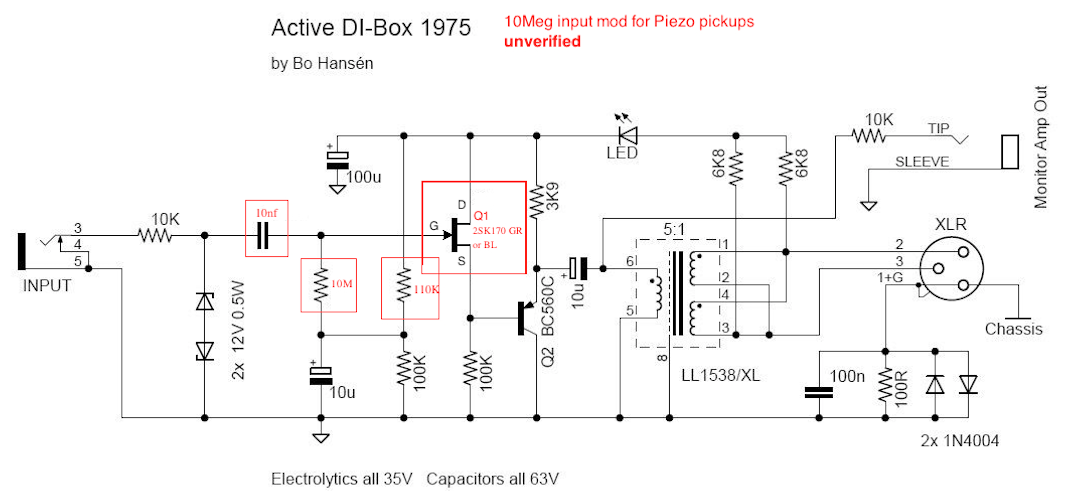Potato Cakes
Well-known member
After a couple of years of using this DI circuit with various transformer options, I now have a better opinion to share regarding the different possibilities.
Carnhill vtb9045- really shines on acoustic instruments that use a piezo pickup for live performances. There is drastic amount of clarity compared to the standard issue off-the-shelf options. Depending on the instrument and the environment, all that is required is a HPF and maybe some low mid cut.
Cinemag CM-9711 - I use this for anything that is a sample based instrument (keyboards, interfaces, drum machine, etc). For whatever reason, especially in a live environment, those type of sources are more easily heard in a thick live mix without the need to push them excessively loud. Typically for this application a passive Radial product (which are fine) is used, but when the dynamic of the music builds, things like keyboards tend to get lost, especially in a venue with subpar acoustics. This design plus the Cinemag seems to alleviate this problem. It even improves the clarity in IEM mixes and performers usually ask for less level due to being able to hear their sample based source better.
Sowter91459045 - If it is a bass, I only use this. It's the more expensive option and requires a larger case, but I have never had a bass guitar have as much clarity from the top to the bottom of its range with as little processing than with this DI configuration. It gets noticed with other bass players and engineers, which is really nice because it allows me to bypass all the Avalon and other gear that you typically see in a bass rig that cause problems more often then they should.
I have built versions with Haufe and OEP transformers, but compared to the ones mentioned above they do not seem to do anything special that would make them better than a passive Radial or some other similar product, but are more convenient as they have a footprint directly on the PCB. I built these with the components and construction methods exactly as prescribed in the assembly instructions, and all of them are noise free without the need for a ground lift. If there was noise it was because the source was generating it and not the DI. I have not found any need to tweak the circuit for different transformers or incoming impedance loads.
Two things that would be nice is for the PCB are to have a couple more options to directly mount different PCBs like JLM does with his Baby Animal preamp boards and a readily available compact enclosure option with engraved I/O labels. But as far as the circuit is concerned I think it is perfect. I definitely think it belongs among the ranks of other revered classic audio designs.
It would be interesting to see results of using different transistors and other components for the sake of science, but for those contemplating building some of these I would say don't bother with trying to figure out crazy modding schemes and to save that time and energy for other builds.
Brilliant work, Mr. Hansen. Thanks for sharing your brain with us DIY peasants.
Thanks!
Paul
Carnhill vtb9045- really shines on acoustic instruments that use a piezo pickup for live performances. There is drastic amount of clarity compared to the standard issue off-the-shelf options. Depending on the instrument and the environment, all that is required is a HPF and maybe some low mid cut.
Cinemag CM-9711 - I use this for anything that is a sample based instrument (keyboards, interfaces, drum machine, etc). For whatever reason, especially in a live environment, those type of sources are more easily heard in a thick live mix without the need to push them excessively loud. Typically for this application a passive Radial product (which are fine) is used, but when the dynamic of the music builds, things like keyboards tend to get lost, especially in a venue with subpar acoustics. This design plus the Cinemag seems to alleviate this problem. It even improves the clarity in IEM mixes and performers usually ask for less level due to being able to hear their sample based source better.
Sowter
I have built versions with Haufe and OEP transformers, but compared to the ones mentioned above they do not seem to do anything special that would make them better than a passive Radial or some other similar product, but are more convenient as they have a footprint directly on the PCB. I built these with the components and construction methods exactly as prescribed in the assembly instructions, and all of them are noise free without the need for a ground lift. If there was noise it was because the source was generating it and not the DI. I have not found any need to tweak the circuit for different transformers or incoming impedance loads.
Two things that would be nice is for the PCB are to have a couple more options to directly mount different PCBs like JLM does with his Baby Animal preamp boards and a readily available compact enclosure option with engraved I/O labels. But as far as the circuit is concerned I think it is perfect. I definitely think it belongs among the ranks of other revered classic audio designs.
It would be interesting to see results of using different transistors and other components for the sake of science, but for those contemplating building some of these I would say don't bother with trying to figure out crazy modding schemes and to save that time and energy for other builds.
Brilliant work, Mr. Hansen. Thanks for sharing your brain with us DIY peasants.
Thanks!
Paul































![Soldering Iron Kit, 120W LED Digital Advanced Solder Iron Soldering Gun kit, 110V Welding Tools, Smart Temperature Control [356℉-932℉], Extra 5pcs Tips, Auto Sleep, Temp Calibration, Orange](https://m.media-amazon.com/images/I/51sFKu9SdeL._SL500_.jpg)





